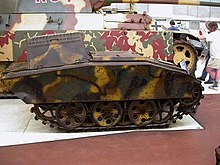Springer (tank)

The Springer (full name: Mittlerer Ladträger Springer , Sd.Kfz. 304 ) was an explosive tank of the German Wehrmacht from the Second World War .
On the basis of the NSU - Kettenkrad , around 50 medium-sized Springer load carriers were developed and built towards the end of the Second World War (known numbers: November 1944: 35 pieces, December 1944: 10 pieces).
In order to carry the higher load despite the missing front fork, the box drive was extended by two pairs of rollers. The jumper thus had three outer and three inner rollers. The Opel Olympia engine, already proven in the Kettenkrad, served as the drive .
The Springer was an explosive tank whose task it was to transport an explosive charge of 330 kilograms under armor protection to an enemy target and detonate it there. For this purpose, the jumper was driven close to the target by a driver sitting in the back. The rest of the journey and the release of the explosive charge were then carried out by cable or radio remote control. As with all such constructions, the high expenditure was out of proportion to the possible military benefit, since every use led to the total loss of the Springer .
In addition to the Springer, the light load carrier Goliath (Sd.Kfz. 302 / 303a / 303b) and the heavy load carrier Borgward IV (Sd.Kfz. 301) were used by the German army during the Second World War , both in significantly larger numbers.
literature
- Markus Jaugitz: The German remote control group . Part 2: 1943-1945. Podzun-Pallas, Wölfersheim-Berstadt 1995, ISBN 3-7909-0529-1 , ( Waffen-Arsenal Special 12).
